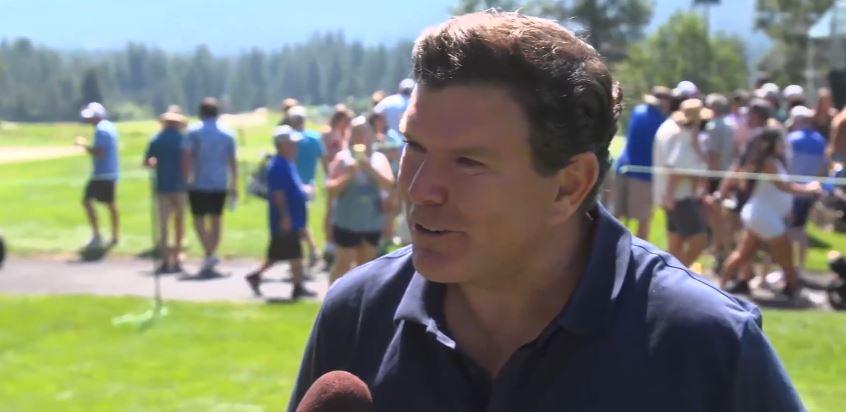
Credit: Entertainment Tonight
Bret Baier’s tone bears the weight of both trauma and victory as he describes his son Paul’s journey. It’s a tale of perseverance, prayer, and surgery—the anatomy of bravery molded by love. Surgeons had to perform Paul’s first open heart surgery a few days after his birth due to five congenital heart defects and his tiny heart pumping incorrectly. Four additional surgeries would be performed over the years to restore equilibrium to a heart that would not stop beating.
However, in 2024, a seemingly common ailment turned into a potentially fatal situation. Following a routine cold, a doctor ordered a precautionary X-ray, which showed Paul’s heart had a golf ball-sized aneurysm. In a matter of hours, the family found themselves back in the comfortable fluorescent light of a hospital, awaiting yet another procedure that might decide their son’s fate.
| Label | Information |
|---|---|
| Name | Bret Baier |
| Profession | Chief Political Correspondent; Anchor of Special Report with Bret Baier |
| Date of Birth | August 4, 1970 — Rumford, Maine, U.S. |
| Family | Wife: Amy Baier; Children: Paul (b. 2007), Daniel |
| Son (Subject) | Paul Baier — born with five congenital heart defects; has undergone five open-heart surgeries and multiple angioplasties |
| Major Medical Event | Emergency open-heart surgery in 2024 after discovery of a golf ball-sized aneurysm |
| Medical Institution | Children’s National Hospital, Washington D.C. |
| Public Contribution | Author of Special Heart: A Journey of Faith, Hope, Courage, and Love; family organizes annual toy drives for hospitalized children |
| Recognition | Widely praised for advocacy in pediatric cardiac awareness and family resilience |
| Reference | People Magazine – “Bret Baier’s Teenage Son Opens Up After Emergency Open-Heart Surgery” (May 2024) |
Bret gave a moving account of the event. “This is a big deal,” he told People after they sat him down. “He wouldn’t have had minutes if it burst.” The sentence collapsed everything else into the present and redefined urgency. The teenager was prepared for another open heart surgery within twelve hours.
The operation was extremely successful despite being extremely complicated. With the help of years of previous procedures and the accumulated faith of a family that had traveled this path far too often, the surgeons worked with precision. The aneurysm was successfully removed. After being repaired and stabilized, Paul’s heart started to slowly and rhythmically heal.
He was sitting up, talking to nurses, and, in typical teenage defiance, asking when he could go home in a matter of days. He did by the fifth day. Later, Bret said, “We were fortunate.” “We couldn’t express how thankful we were.” The phrase “gratitude is the attitude” is frequently used as a family motto in the Baier home, where it has become a recurring theme. It’s more than just a phrase; it’s the way they choose to interpret each setback, turning fear into insight.
Despite being extremely personal, Paul’s story has touched people well beyond his family. Every medical milestone feels like a victory parade, and every diagnosis feels like a test of endurance, reflecting the silent struggles of innumerable parents dealing with pediatric illness. The Baiers have transformed their personal struggles into a cause that benefits the public over time. Their yearly toy drives and fundraising initiatives have brought resources and happiness to kids who now have to navigate the same sterile hallways their son used to.
Since it is a continuation of survival rather than a publicity stunt, this cycle of giving back is especially novel. According to Amy Baier, Children’s National and other hospitals “give families back their tomorrows.” Much of their advocacy, especially for early testing programs and congenital heart research, has been characterized by this sentiment. Many people have found resonance in their belief that “small checks save lives,” which motivates families to demand additional testing when symptoms don’t add up.
Paul’s illness also demonstrates the astounding advancements in contemporary pediatric cardiology. Infants with multiple congenital heart defects had much lower survival rates just twenty years ago. Today, children like Paul are not just surviving, but thriving, thanks to extremely effective surgical advancements and early detection. His life serves as evidence that medical advancement combined with unwavering parental support can lead to previously unthinkable results.
Bret Baier has juggled his public responsibilities with personal suffering during each surgery. Being one of the most well-known anchors in America, he has mastered the ability to quickly transition from political discussions to hospital updates, a skill that requires emotional flexibility. He once acknowledged that although his work prepares him for life’s challenges, nothing can match the uncertainty of a child’s medical battle.
The most notable aspect of Bret’s recounting is not hopelessness but rather perspective. He admitted, “You would do anything to replace your child when you watch them walk down that hallway.” “However, we could never teach Paul as much about strength as he does.” That sentiment encapsulates a universal reality: quiet acts of bravery are frequently used to transmit resilience from child to parent.
Even Paul now speaks with a level of maturity that is far above his years. “A lot can change in five hours,” he stated in an interview. It’s critical to express gratitude for all that you have each and every day. Despite their simplicity, his words convey the weight of experience. It’s a striking example of how surviving near-death experiences alters one’s perception of time, turning each sunrise into a tiny miracle.
Once put to the test by medical uncertainty, the family’s faith has grown into a source of inspiration. They freely acknowledge the influence of prayer, recounting instances in which the goal of the group seemed almost real. Amy remembers seeing “beams of light” encircling Paul’s hospital bed; this image has stuck with her, representing the unseen power that love, faith, and community can offer during the most trying times.
Their public displays of resiliency have inspired many families to exercise caution. The Baiers have given parents the confidence to take on the role of advocates for their children’s health by being open about misdiagnoses, delayed detections, and the value of proactive care. Bret’s book Special Heart’s emotional candor still soothes readers dealing with comparable anxieties by providing consolation and a plan for overcoming protracted medical difficulties.
This story’s optimism for the future is what makes it so poignant. Paul has had five open heart surgeries, but his spirit has not faltered. He is a living example of how a heart that has been repaired can still beat ferociously with ambition because he participates in sports, goes to school, and hopes to attend college. Bret refers to him as “a warrior,” a designation attained via perseverance, humor, and a refusal to back down rather than via actual combat.
Their experience serves as a powerful reminder that while medicine can heal physical ailments, love and faith are what truly save lives. The Baiers have shown through hardship that strength does not always roar but can occasionally be whispered through faith, patience, and thankfulness.
Paul is making plans for the future now that his recuperation has significantly improved and his energy is gradually returning. Although minor procedures might be performed, the doctors think that major surgeries are behind him. For his parents, however, each typical day is a triumph—an additional opportunity to lead the typical life they once thought they would lose.

